Taesoo Kim
ATLANTIS: AI-driven Threat Localization, Analysis, and Triage Intelligence System
Sep 18, 2025
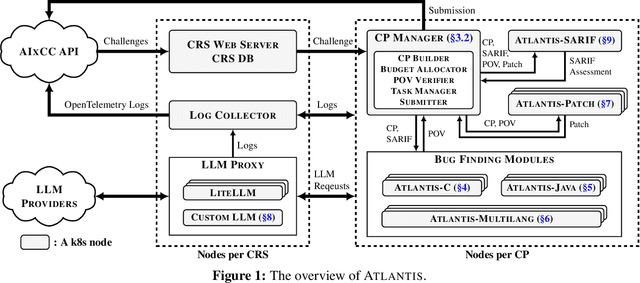

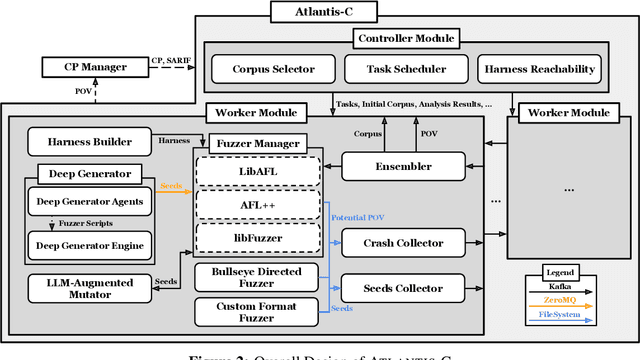
Abstract:We present ATLANTIS, the cyber reasoning system developed by Team Atlanta that won 1st place in the Final Competition of DARPA's AI Cyber Challenge (AIxCC) at DEF CON 33 (August 2025). AIxCC (2023-2025) challenged teams to build autonomous cyber reasoning systems capable of discovering and patching vulnerabilities at the speed and scale of modern software. ATLANTIS integrates large language models (LLMs) with program analysis -- combining symbolic execution, directed fuzzing, and static analysis -- to address limitations in automated vulnerability discovery and program repair. Developed by researchers at Georgia Institute of Technology, Samsung Research, KAIST, and POSTECH, the system addresses core challenges: scaling across diverse codebases from C to Java, achieving high precision while maintaining broad coverage, and producing semantically correct patches that preserve intended behavior. We detail the design philosophy, architectural decisions, and implementation strategies behind ATLANTIS, share lessons learned from pushing the boundaries of automated security when program analysis meets modern AI, and release artifacts to support reproducibility and future research.
Towards Human-like Multimodal Conversational Agent by Generating Engaging Speech
Sep 18, 2025Abstract:Human conversation involves language, speech, and visual cues, with each medium providing complementary information. For instance, speech conveys a vibe or tone not fully captured by text alone. While multimodal LLMs focus on generating text responses from diverse inputs, less attention has been paid to generating natural and engaging speech. We propose a human-like agent that generates speech responses based on conversation mood and responsive style information. To achieve this, we build a novel MultiSensory Conversation dataset focused on speech to enable agents to generate natural speech. We then propose a multimodal LLM-based model for generating text responses and voice descriptions, which are used to generate speech covering paralinguistic information. Experimental results demonstrate the effectiveness of utilizing both visual and audio modalities in conversation to generate engaging speech. The source code is available in https://github.com/kimtaesu24/MSenC
Do Not Mimic My Voice: Speaker Identity Unlearning for Zero-Shot Text-to-Speech
Jul 27, 2025Abstract:The rapid advancement of Zero-Shot Text-to-Speech (ZS-TTS) technology has enabled high-fidelity voice synthesis from minimal audio cues, raising significant privacy and ethical concerns. Despite the threats to voice privacy, research to selectively remove the knowledge to replicate unwanted individual voices from pre-trained model parameters has not been explored. In this paper, we address the new challenge of speaker identity unlearning for ZS-TTS systems. To meet this goal, we propose the first machine unlearning frameworks for ZS-TTS, especially Teacher-Guided Unlearning (TGU), designed to ensure the model forgets designated speaker identities while retaining its ability to generate accurate speech for other speakers. Our proposed methods incorporate randomness to prevent consistent replication of forget speakers' voices, assuring unlearned identities remain untraceable. Additionally, we propose a new evaluation metric, speaker-Zero Retrain Forgetting (spk-ZRF). This assesses the model's ability to disregard prompts associated with forgotten speakers, effectively neutralizing its knowledge of these voices. The experiments conducted on the state-of-the-art model demonstrate that TGU prevents the model from replicating forget speakers' voices while maintaining high quality for other speakers. The demo is available at https://speechunlearn.github.io/
ReInc: Scaling Training of Dynamic Graph Neural Networks
Jan 25, 2025Abstract:Dynamic Graph Neural Networks (DGNNs) have gained widespread attention due to their applicability in diverse domains such as traffic network prediction, epidemiological forecasting, and social network analysis. In this paper, we present ReInc, a system designed to enable efficient and scalable training of DGNNs on large-scale graphs. ReInc introduces key innovations that capitalize on the unique combination of Graph Neural Networks (GNNs) and Recurrent Neural Networks (RNNs) inherent in DGNNs. By reusing intermediate results and incrementally computing aggregations across consecutive graph snapshots, ReInc significantly enhances computational efficiency. To support these optimizations, ReInc incorporates a novel two-level caching mechanism with a specialized caching policy aligned to the DGNN execution workflow. Additionally, ReInc addresses the challenges of managing structural and temporal dependencies in dynamic graphs through a new distributed training strategy. This approach eliminates communication overheads associated with accessing remote features and redistributing intermediate results. Experimental results demonstrate that ReInc achieves up to an order of magnitude speedup compared to state-of-the-art frameworks, tested across various dynamic GNN architectures and real-world graph datasets.
HetTree: Heterogeneous Tree Graph Neural Network
Feb 21, 2024



Abstract:The recent past has seen an increasing interest in Heterogeneous Graph Neural Networks (HGNNs) since many real-world graphs are heterogeneous in nature, from citation graphs to email graphs. However, existing methods ignore a tree hierarchy among metapaths, which is naturally constituted by different node types and relation types. In this paper, we present HetTree, a novel heterogeneous tree graph neural network that models both the graph structure and heterogeneous aspects in a scalable and effective manner. Specifically, HetTree builds a semantic tree data structure to capture the hierarchy among metapaths. Existing tree encoding techniques aggregate children nodes by weighting the contribution of children nodes based on similarity to the parent node. However, we find that this tree encoding fails to capture the entire parent-children hierarchy by only considering the parent node. Hence, HetTree uses a novel subtree attention mechanism to emphasize metapaths that are more helpful in encoding parent-children relationships. Moreover, instead of separating feature learning from label learning or treating features and labels equally by projecting them to the same latent space, HetTree proposes to match them carefully based on corresponding metapaths, which provides more accurate and richer information between node features and labels. Our evaluation of HetTree on a variety of real-world datasets demonstrates that it outperforms all existing baselines on open benchmarks and efficiently scales to large real-world graphs with millions of nodes and edges.
RainSD: Rain Style Diversification Module for Image Synthesis Enhancement using Feature-Level Style Distribution
Dec 31, 2023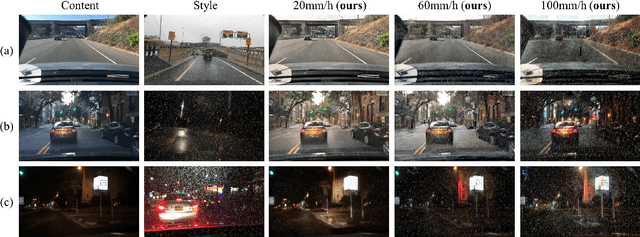

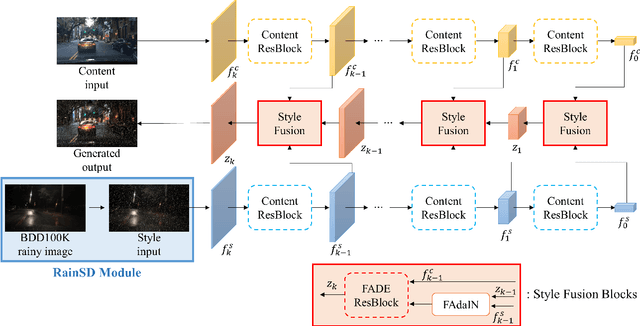

Abstract:Autonomous driving technology nowadays targets to level 4 or beyond, but the researchers are faced with some limitations for developing reliable driving algorithms in diverse challenges. To promote the autonomous vehicles to spread widely, it is important to address safety issues on this technology. Among various safety concerns, the sensor blockage problem by severe weather conditions can be one of the most frequent threats for multi-task learning based perception algorithms during autonomous driving. To handle this problem, the importance of the generation of proper datasets is becoming more significant. In this paper, a synthetic road dataset with sensor blockage generated from real road dataset BDD100K is suggested in the format of BDD100K annotation. Rain streaks for each frame were made by an experimentally established equation and translated utilizing the image-to-image translation network based on style transfer. Using this dataset, the degradation of the diverse multi-task networks for autonomous driving, such as lane detection, driving area segmentation, and traffic object detection, has been thoroughly evaluated and analyzed. The tendency of the performance degradation of deep neural network-based perception systems for autonomous vehicle has been analyzed in depth. Finally, we discuss the limitation and the future directions of the deep neural network-based perception algorithms and autonomous driving dataset generation based on image-to-image translation.
PAC Neural Prediction Set Learning to Quantify the Uncertainty of Generative Language Models
Jul 18, 2023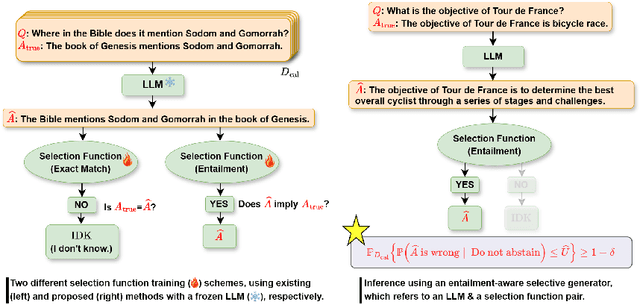
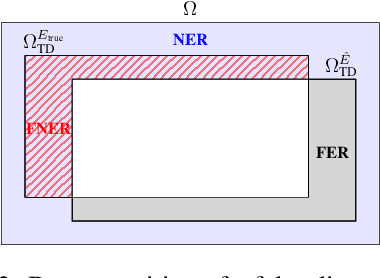
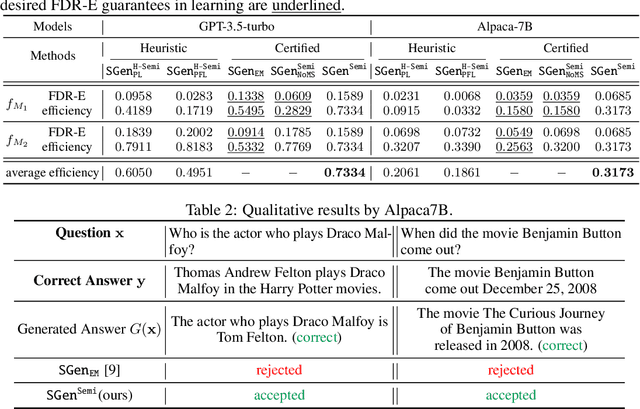
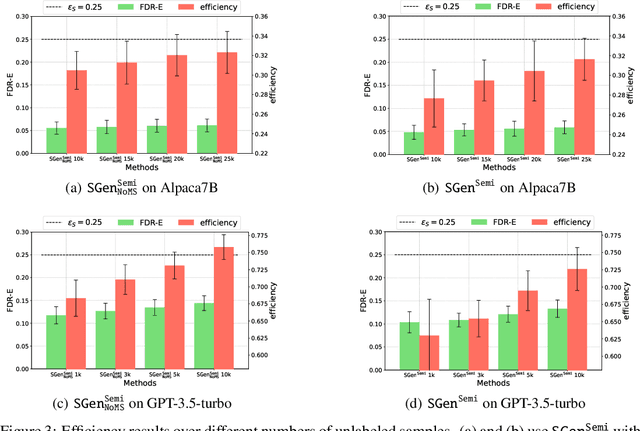
Abstract:Uncertainty learning and quantification of models are crucial tasks to enhance the trustworthiness of the models. Importantly, the recent surge of generative language models (GLMs) emphasizes the need for reliable uncertainty quantification due to the concerns on generating hallucinated facts. In this paper, we propose to learn neural prediction set models that comes with the probably approximately correct (PAC) guarantee for quantifying the uncertainty of GLMs. Unlike existing prediction set models, which are parameterized by a scalar value, we propose to parameterize prediction sets via neural networks, which achieves more precise uncertainty quantification but still satisfies the PAC guarantee. We demonstrate the efficacy of our method on four types of language datasets and six types of models by showing that our method improves the quantified uncertainty by $63\%$ on average, compared to a standard baseline method.
Enhancing Breast Cancer Risk Prediction by Incorporating Prior Images
Mar 28, 2023Abstract:Recently, deep learning models have shown the potential to predict breast cancer risk and enable targeted screening strategies, but current models do not consider the change in the breast over time. In this paper, we present a new method, PRIME+, for breast cancer risk prediction that leverages prior mammograms using a transformer decoder, outperforming a state-of-the-art risk prediction method that only uses mammograms from a single time point. We validate our approach on a dataset with 16,113 exams and further demonstrate that it effectively captures patterns of changes from prior mammograms, such as changes in breast density, resulting in improved short-term and long-term breast cancer risk prediction. Experimental results show that our model achieves a statistically significant improvement in performance over the state-of-the-art based model, with a C-index increase from 0.68 to 0.73 (p < 0.05) on held-out test sets.
ACon$^2$: Adaptive Conformal Consensus for Provable Blockchain Oracles
Nov 17, 2022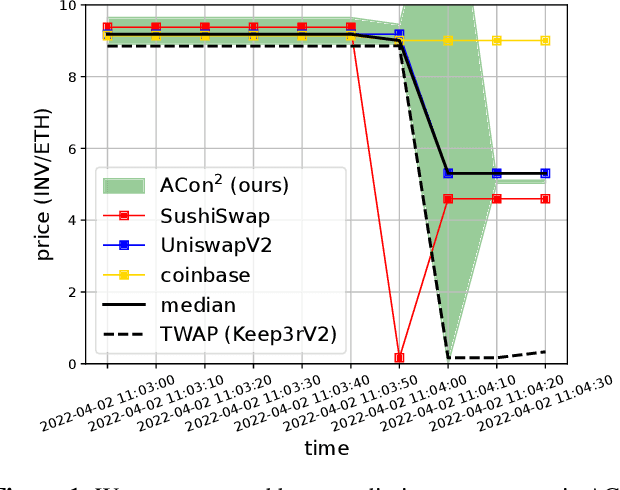
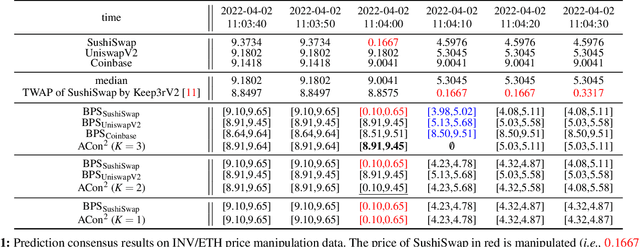
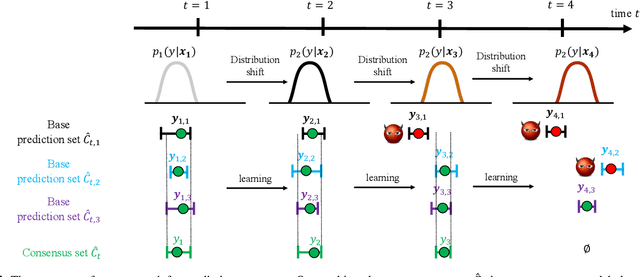

Abstract:Blockchains with smart contracts are distributed ledger systems which achieve block state consistency among distributed nodes by only allowing deterministic operations of smart contracts. However, the power of smart contracts is enabled by interacting with stochastic off-chain data, which in turn opens the possibility to undermine the block state consistency. To address this issue, an oracle smart contract is used to provide a single consistent source of external data; but, simultaneously this introduces a single point of failure, which is called the oracle problem. To address the oracle problem, we propose an adaptive conformal consensus (ACon$^2$) algorithm, which derives consensus from multiple oracle contracts via the recent advance in online uncertainty quantification learning. In particular, the proposed algorithm returns a consensus set, which quantifies the uncertainty of data and achieves a desired correctness guarantee in the presence of Byzantine adversaries and distribution shift. We demonstrate the efficacy of the proposed algorithm on two price datasets and an Ethereum case study. In particular, the Solidity implementation of the proposed algorithm shows the practicality of the proposed algorithm, implying that online machine learning algorithms are applicable to address issues in blockchains.
Unsafe's Betrayal: Abusing Unsafe Rust in Binary Reverse Engineering toward Finding Memory-safety Bugs via Machine Learning
Oct 31, 2022Abstract:Memory-safety bugs introduce critical software-security issues. Rust provides memory-safe mechanisms to avoid memory-safety bugs in programming, while still allowing unsafe escape hatches via unsafe code. However, the unsafe code that enhances the usability of Rust provides clear spots for finding memory-safety bugs in Rust source code. In this paper, we claim that these unsafe spots can still be identifiable in Rust binary code via machine learning and be leveraged for finding memory-safety bugs. To support our claim, we propose the tool textttrustspot, that enables reverse engineering to learn an unsafe classifier that proposes a list of functions in Rust binaries for downstream analysis. We empirically show that the function proposals by textttrustspot can recall $92.92\%$ of memory-safety bugs, while it covers only $16.79\%$ of the entire binary code. As an application, we demonstrate that the function proposals are used in targeted fuzzing on Rust packages, which contribute to reducing the fuzzing time compared to non-targeted fuzzing.
 Add to Chrome
Add to Chrome Add to Firefox
Add to Firefox Add to Edge
Add to Edge